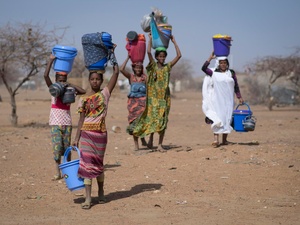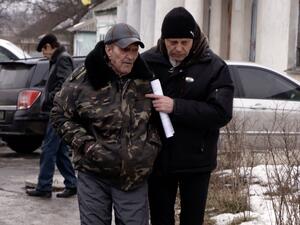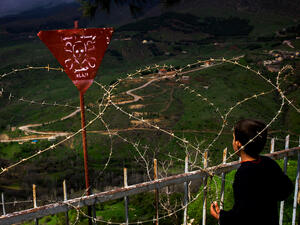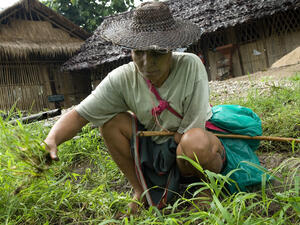Geneva exhibition seeks to raise awareness of landmines
Geneva exhibition seeks to raise awareness of landmines
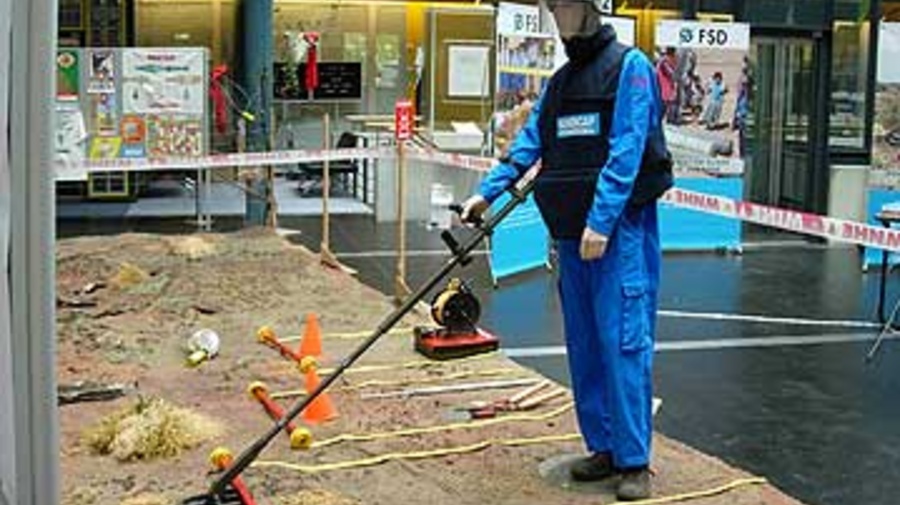
A mock minefield set up by Handicap International at the Mine Action exhibition in UNHCR Geneva.
GENEVA, May 18 (UNHCR) - Landmines are one of war's longest-lasting and most difficult to eradicate legacies. They are one of the most significant obstacles to voluntary repatriation and successful reintegration in many countries where UNHCR works, and mine clearance and awareness are often integral parts of a successful repatriation programme.
To drive home the importance of mine awareness, a three-day Mine Action exhibition is currently running at the UN refugee agency headquarters in Geneva. The building's reception area has been turned into a mock minefield, with a 10-m2 plot of land filled with fake mines, unexploded ordnance (UXOs) and de-mining tools.
Organised by the UN Mine Action Service (UNMAS), Fédération Suisse de Déminage (FSD), the Geneva International Centre for Humanitarian De-mining, Italian non-governmental organisation Intersos, and Handicap International, the exhibition also features reports, presentations, photos and videos on mine awareness, victim assistance and de-mining projects in countries like Angola, Bosnia and Herzegovina, Iraq and Pakistan.
"It is very rare to have mine information in any country. Maps are useless and rendered immediately obsolete," a World Food Programme spokesperson told UNHCR staff and visitors on Wednesday.
"If there is one mine, you can expect others," cautioned UNMAS's Sebastian Kasach. "Do not be tempted when people want to show you a mine they just found. Local communities often do not know where the minefields really begin."
He added, "Try to imagine the logic behind where and why armies put mines - in abandoned buildings, where there are signs of fighting, casualties, dead animals, military positions and strategic places near the border or in overgrown areas. For example, ask yourself why no one picks the mango trees in Angola."
Kasach reminded his audience that landmines can still explode decades later and that sending livestock through a minefield does not clear it completely. Throughout his presentation, he repeated: "Be aware of the threat. Stay away, record and report," and offered advice on what to do if caught in a minefield.
Such awareness has proven crucial in many UNHCR operations around the world. In Angola, landmines are a major obstacle to repatriation. In Afghanistan, every refugee who returns home from Iran and Pakistan with UNHCR is given mine-awareness training. In one of UNHCR's major operations in Africa, efforts are currently underway to make southern Sudan safe for voluntary repatriation later this year.
For seven years, Isaac Rasakani was a soldier with the Sudan People's Liberation Army. His specialty was landmines: spotting them and laying them down. Now that peace has come to southern Sudan, Rasakani is using his war experience to help rebuild his region. He is now part of a team of local people who, under the management of FSD, are working to clear southern Sudan of landmines.
The task is daunting. No one knows for sure how many landmines were laid during a war that lasted for more than two decades and brought utter devastation to southern Sudan. The entire region needs to be cleared. For the time being, Rasakani and his team are focusing on clearing the roads - or in many cases, opening a corridor where the roads will be, since most roads were destroyed during the war and will have to be rebuilt. It's painstaking work - on a good day, Rasakani and his 12-men team clear about 250 metres of road.
It is also essential work, not only for the people who live in southern Sudan now, but also for the thousands who want to come back home. Some two to three million people fled southern Sudan during the war, including half a million who took refuge in neighbouring countries like Uganda, Kenya and the Democratic Republic of the Congo. Many now want to return, and UNHCR is hoping to start a voluntary repatriation programme to southern Sudan later this year.
The Yei to Juba road, which Rasakani and his team are now de-mining, will be one of the main repatriation corridors. When people come back, they will of course need land to live on and cultivate: unless the land is cleared, they will not be able to return.
Moses Taban can testify to the dangers of coming home to a region riddled with mines. Eighteen months ago, he came back to southern Sudan with his wife and child after seven years of being a refugee in Uganda. After such a long time away, Taban had no way of knowing that the field at the back of what had once been his home had been heavily mined. Only a few days after his return, he stepped on a landmine while he was out collecting bamboo to build a house for his family. He lost his left leg in the blast, and has been in constant pain ever since.
"No one told me about the mines," he said. "The people here thought that I would know. Now they have organised training for the refugees who come back, especially the children. But for me, it is too late."
By Haude Morel in Geneva
and Marie-Hélène Verney in Sudan


